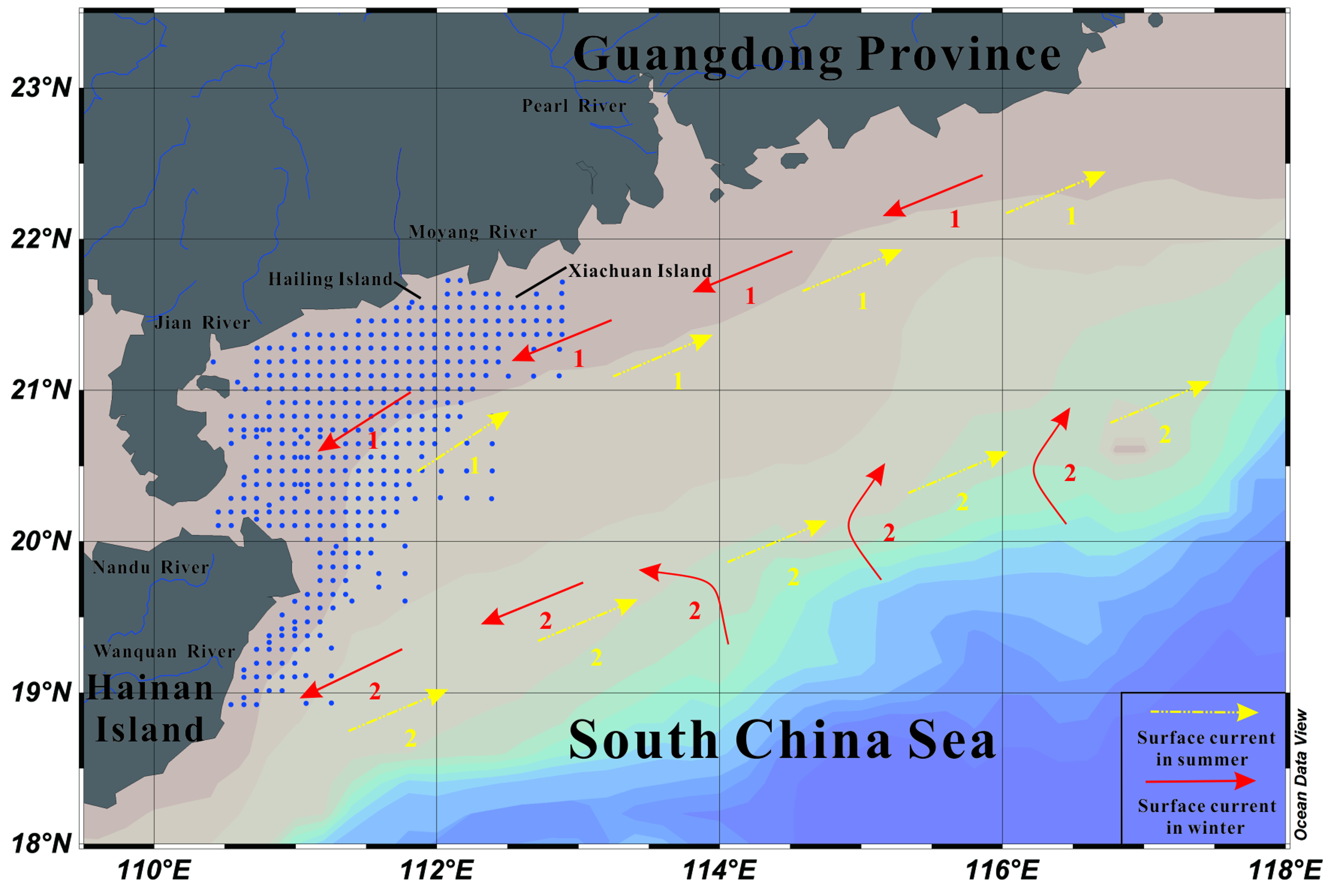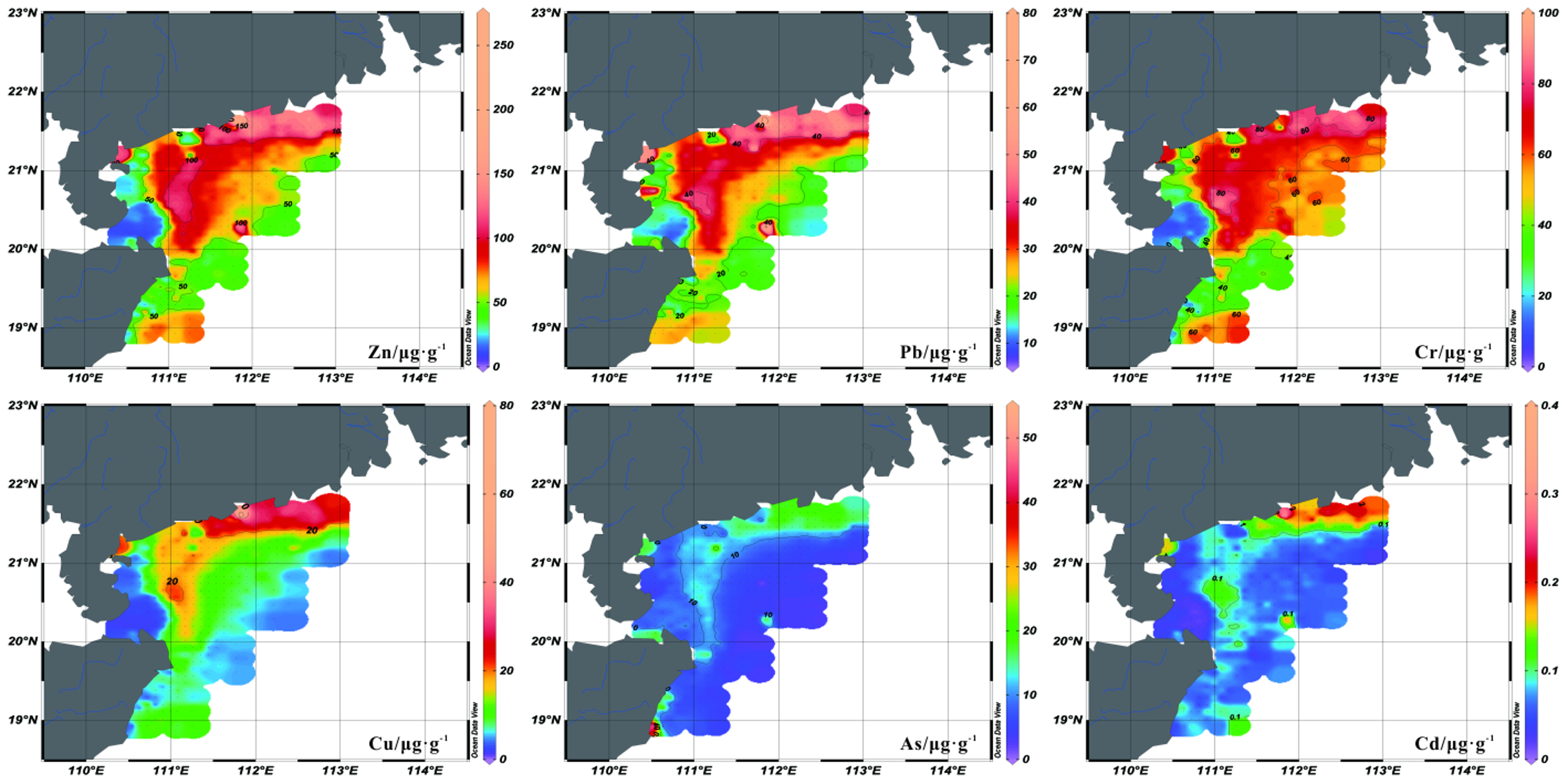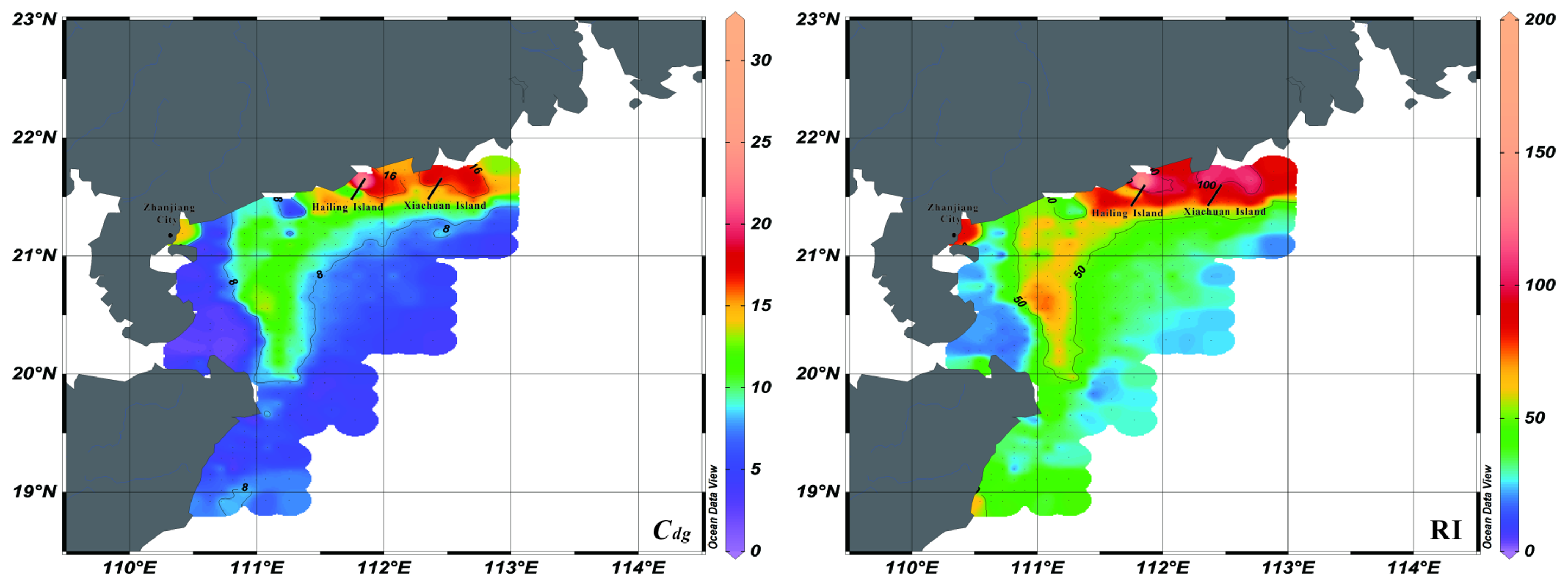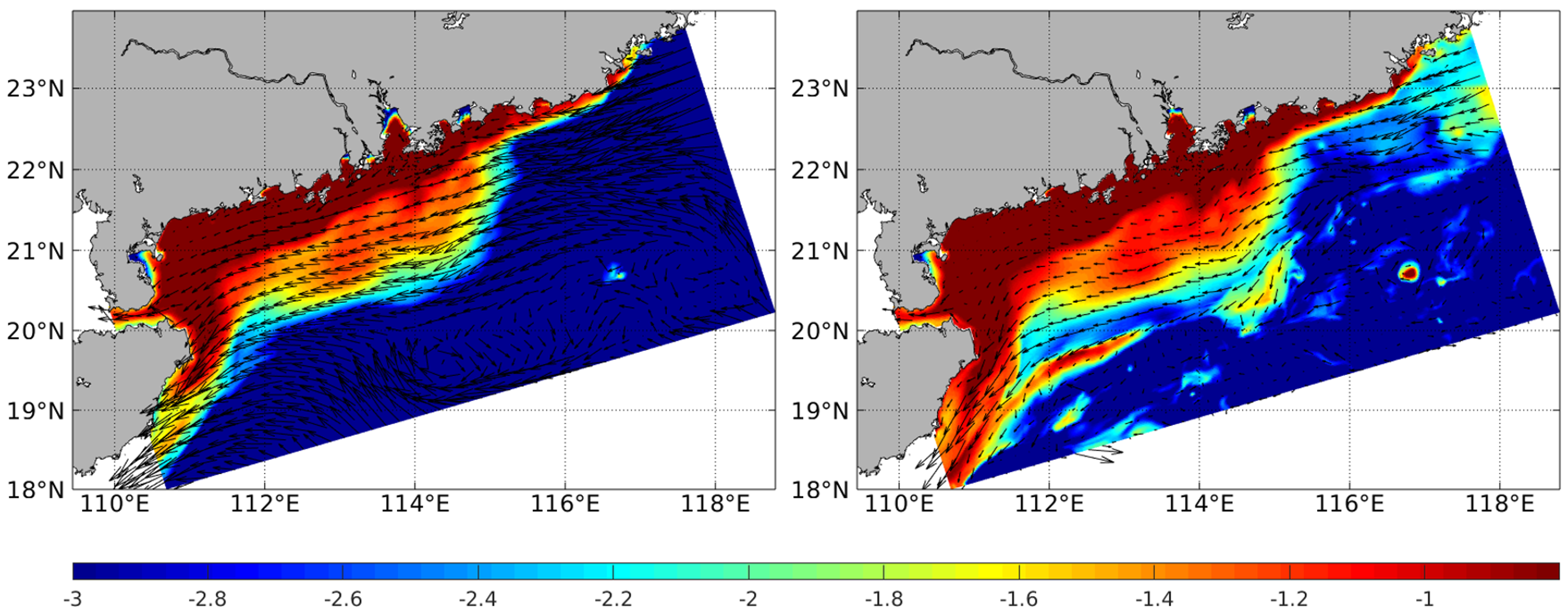Spatial Distribution and Contamination Assessment of Surface Heavy Metals off the Western Guangdong Province and Northeastern Hainan Island
Abstract
1. Introduction
2. Materials and Methods
2.1. Study Area
2.2. Sample Collection and Analytical Methods
2.3. Assessment Methods
2.3.1. Index of Geo-Accumulation (Igeo)
2.3.2. PERI
2.4. Statistical Methods
3. Results and Discussion
3.1. Contents and Spatial Distribution of Heavy Metals in the Surface Sediments
3.2. Pollution Assessment
3.3. Controlling Factors of Heavy Metals Distribution and Sources Identification
4. Conclusions
Author Contributions
Acknowledgments
Conflicts of Interest
References
- Pan, K.; Wang, W.X. Trace metal contamination in estuarine and coastal environments in China. Sci. Total Environ. 2012, 421–422, 3–16. [Google Scholar] [CrossRef] [PubMed]
- Tessier, A.; Campbell, P.G.C. Partitioning of trace metals in sediments: Relationships with bioavailability. Hydrobiologia 1987, 149, 43–52. [Google Scholar] [CrossRef]
- Wang, Y.Q.; Yang, L.Y.; Kong, L.H.; Liu, E.; Wang, L.; Zhu, J. Spatial distribution, ecological risk assessment and source identification for heavy metals in surface sediments from Dongping Lake, Shandong, East China. Catena 2015, 125, 200–205. [Google Scholar] [CrossRef]
- Ip, C.C.M.; Li, X.D.; Zhang, G.; Wai, O.W.; Li, Y.S. Trace metal distribution in sediments of the Pearl River Estuary and the surrounding coastal area, South China. Environ. Pollut. 2007, 147, 311–323. [Google Scholar] [CrossRef] [PubMed]
- Hernandez, O.C.; Hoz, L.R.; Cundy, A.B.; Carranza-Edwards, A. Sedimentary heavy metal(loid) contamination in the Veracruz shelf, Gulf of Mexico: A baseline survey from a rapidly developing tropical coast. Mar. Pollut. Bull. 2017, 119, 204–213. [Google Scholar] [CrossRef] [PubMed]
- Lu, J.; Li, A.C.; Huang, P. Distribution, sources and contamination assessment of heavy metals in surface sediments of the South Yellow Sea and northern part of the East China Sea. Mar. Pollut. Bull. 2017, 124, 470–479. [Google Scholar] [CrossRef] [PubMed]
- Zhang, Z.Q.; Chen, L.; Wang, W.P.; Li, T.; Zu, T. The origin, historical variations, and distribution of heavy metals in the Qiongzhou Strait and nearby marine areas. J. Ocean Univ. China 2017, 16, 262–268. [Google Scholar] [CrossRef]
- Chen, F.J.; Lin, J.; Qian, B.H.; Wu, Z.; Huang, P.; Chen, K.; Li, T.; Cai, M. Geochemical assessment and spatial analysis of heavy metals in the surface sediments in the eastern Beibu Gulf: A reflection on the industrial development of the South China coast. Int. J. Environ. Res. Public Health 2018, 15, 496. [Google Scholar] [CrossRef] [PubMed]
- Liu, J.J.; Ni, Z.X.; Diao, Z.H.; Hu, Y.X.; Xu, X.R. Contamination level, chemical fraction and ecological risk of heavy metals in sediments from Daya Bay, South China Sea. Mar. Pollut. Bull. 2018, 128, 132–139. [Google Scholar] [CrossRef] [PubMed]
- Milliman, J.D.; Farnsworth, K.L. River Discharge to the Coastal Ocean: A Global Synthesis; Cambridge University Press: Cambridge, UK, 2011; pp. 1–384. [Google Scholar]
- Shaw, P.-T.; Chao, S.-Y. Surface circulation in the South China Sea. Deep Sea Res. Part I 1994, 41, 1663–1683. [Google Scholar] [CrossRef]
- Su, J.L. Overview of the South China Sea circulation and its influence on the coastal physical oceanography near the Pearl River Estuary. Cont. Shelf Res. 2004, 24, 1745–1760. [Google Scholar]
- Liu, Z.F.; Colin, C.; Li, X.J.; Zhao, Y.; Tuo, S.; Chen, Z.; Siringan, F.P.; Liu, J.T.; Huang, C.-Y.; You, C.-F.; et al. Clay mineral distribution in surface sediments of the northeastern South China Sea and surrounding fluvial drainage basins: Source and transport. Mar. Geol. 2010, 277, 48–60. [Google Scholar] [CrossRef]
- Loring, D.H.; Rantala, R.T.T. Manual for the geochemical analyses of marine sediments and suspended particulate matter. Earth-Sci. Rev. 1992, 32, 235–283. [Google Scholar] [CrossRef]
- Müller, G. Index of geoaccumulation in sdiments of the Rhine River. Geojournal 1969, 2, 108–118. [Google Scholar]
- Müller, G. Schwermetalle in den Sedimenten des Rheins-Veränderungen seit 1971. Umschau 1979, 79, 778–783. [Google Scholar]
- Li, J.; Zheng, C.J. Handbook of Environmental Background Values; China Environmental Science Press: Beijing, China, 1988; pp. 1–403. (In Chinese) [Google Scholar]
- Fostner, U.; Müller, G. Concentration of trace metals and polycyclic aromatic hycarbons in river sediments: Geochemical background, man’s influence and environmental impact. Geojournal 1981, 5, 417–432. [Google Scholar] [CrossRef]
- Dung, T.T.T.; Cappuyns, V.; Swennen, R.; Phung, N.K. From geochemical background determination to pollution assessment of heavy metals in sediments and soils. Rev. Environ. Sci. Biotechnol. 2013, 12, 335–353. [Google Scholar] [CrossRef]
- Hakanson, L. An ecological risk index for aquatic pollution control: A sedimentological approach. Water Res. 1980, 14, 975–1001. [Google Scholar] [CrossRef]
- Kwon, Y.T.; Lee, C.W. Application of multiple ecological risk indexes for the evaluation of heavy metal contamination in a coastal dredging area. Sci. Total Environ. 1998, 214, 203–210. [Google Scholar] [CrossRef]
- Selvaraj, K.; Ram Mohan, V.; Szefer, P. Evaluation of metal contamination in coastal sediments of the Bay of Bengal, India: Geochemical and statistical approach. Mar. Pollut. Bull. 2004, 49, 174–185. [Google Scholar] [CrossRef] [PubMed]
- Mali, M.; Dell’Anna, M.M.; Notarnicola, M.; Damiani, L.; Mastrorilli, P. Combining chemometric tools for assessing hazard sources and factors acting simultaneously in contaminated areas. Case study: “Mar Piccolo” Taranto (South Italy). Chemosphere 2017, 184, 784–794. [Google Scholar] [CrossRef] [PubMed]
- Chu, F.Y.; Long, J.P.; Zhang, F.Y.; Zhang, W.Y.; Ye, L.M.; Yang, K.H.; Yang, H.L.; Xu, D.; Ge, Q.; Dong, Y.H.; et al. Report of the Marine Sediment’s Characteristic in Zone CJ17; Second Institute of Oceanography, State Oceanic Administration: Hangzhou, China, 2010; pp. 16–47. (In Chinese) [Google Scholar]
- Li, G.; Yan, W.; Li, Z.F. Element geochemistry of offshore sediments in the northwestern South China Sea and the dispersal of Pearl River sediments. Prog. Oceanogr. 2016, 141, 17–29. [Google Scholar] [CrossRef]
- Ge, Q.; Liu, J.P.; Xue, Z.; Chu, F. Dispersal of the Zhujiang River (Pearl River) derived sediment in the Holocene. Acta Oceanol. Sin. 2014, 33, 1–9. [Google Scholar] [CrossRef]
- Liu, F.W.; Yan, W.; Huang, X.P.; Shi, P. Distributional characteristics of heavy metal and its available phases in sediments from Zhujiang River mouth. J. Trop. Oceanogr. 2003, 22, 16–24, (In Chinese with English abstract). [Google Scholar]
- Chen, J.S. Aquatic Chemistry; Higher Education Press: Beijing, China, 1987; pp. 1–302. (In Chinese) [Google Scholar]
- Liu, S.F.; Shi, X.F.; Yang, G.; Somkiat, K.; Narumol, K. Concentration distribution and assessment of heavy metals in the surface sediments of the western Gulf of Thailand. Environ. Earth Sci. 2016, 75, 346. [Google Scholar] [CrossRef]
- Shchepetkin, A.F.; McWilliams, J.C. The regional oceanic modeling system (ROMS): A split-explicit, free-surface, topography-following-coordinate oceanic model. Ocean Model. 2005, 9, 347–404. [Google Scholar] [CrossRef]
- Yang, Z.S.; Guo, Z.G.; Wang, Z.X.; Xu, J.P.; Gao, W.B. The macro pattern of suspended particulate matter transport to the eastern open ocean on the Yellow and East China Sea shelf. Acta Oceanol. Sin. 1992, 14, 81–90. (In Chinese) [Google Scholar]
- Chen, L.; Li, T.J.; Yang, W.F.; Chen, J. Distribution and sources of heavy metals in surface sediments, northern South China Sea. Ecol. Environ. Sci. 2016, 25, 464–470, (In Chinese with English abstract). [Google Scholar]





| Igeo | Class | Pollution Level |
|---|---|---|
| <0 | 0 | Unpolluted |
| 0–1 | 1 | Unpolluted to moderately polluted |
| 1–2 | 2 | Moderately polluted |
| 2–3 | 3 | Moderately to strongly polluted |
| 3–4 | 4 | Strongly polluted |
| 4–5 | 5 | Strongly to very strongly polluted |
| >5 | 6 | Very strongly polluted |
| Degree of Contamination | RI | Grade of Potential Ecological Risk to the Environment | |
|---|---|---|---|
| <6 | low pollution | <150 | low potential risk |
| 6–12 | moderate pollution | 150–300 | moderate potential risk |
| 12–24 | high pollution | 300–600 | high potential risk |
| ≥24 | severe pollution | ≥600 | severe potential risk |
| As | Cd | Cr | Cu | Pb | Zn | Mz | |
|---|---|---|---|---|---|---|---|
| As | 1 | ||||||
| Cd | 0.594 ** | 1 | |||||
| Cr | 0.347 ** | 0.651 ** | 1 | ||||
| Cu | 0.599 ** | 0.894 ** | 0.763 ** | 1 | |||
| Pb | 0.626 ** | 0.828 ** | 0.816 ** | 0.915 ** | 1 | ||
| Zn | 0.492 ** | 0.829 ** | 0.911 ** | 0.924 ** | 0.931 ** | 1 | |
| Mz | 0.168 ** | 0.571 ** | 0.845 ** | 0.630 ** | 0.688 ** | 0.790 ** | 1 |
| Parameter | Cd | Cr | Cu | Pb | Zn | As |
|---|---|---|---|---|---|---|
| Maximum (μg/g) | 0.40 | 93.50 | 111.80 | 78.10 | 251.90 | 50.55 |
| Minimum (μg/g) | 0.02 | 8.20 | 2.10 | 8.90 | 8.00 | 0.37 |
| Average (μg/g) | 0.08 | 56.71 | 17.72 | 28.71 | 74.22 | 9.14 |
| Coefficient of variance (%) | 51.86 | 35.53 | 64.88 | 36.73 | 45.41 | 52.67 |
| Component | F1 | F2 |
|---|---|---|
| Cd | 0.580 | 0.701 |
| Cr | 0.912 | 0.268 |
| Cu | 0.677 | 0.678 |
| Pb | 0.716 | 0.645 |
| Zn | 0.848 | 0.499 |
| As | 0.045 | 0.938 |
| Mz | 0.942 | 0.053 |
| Variance % | 53.5 | 36.7 |
| Cumulative variance % | 53.5 | 90.2 |
© 2018 by the authors. Licensee MDPI, Basel, Switzerland. This article is an open access article distributed under the terms and conditions of the Creative Commons Attribution (CC BY) license (http://creativecommons.org/licenses/by/4.0/).
Share and Cite
Ge, Q.; Xue, Z.G.; Chu, F. Spatial Distribution and Contamination Assessment of Surface Heavy Metals off the Western Guangdong Province and Northeastern Hainan Island. Int. J. Environ. Res. Public Health 2018, 15, 1897. https://doi.org/10.3390/ijerph15091897
Ge Q, Xue ZG, Chu F. Spatial Distribution and Contamination Assessment of Surface Heavy Metals off the Western Guangdong Province and Northeastern Hainan Island. International Journal of Environmental Research and Public Health. 2018; 15(9):1897. https://doi.org/10.3390/ijerph15091897
Chicago/Turabian StyleGe, Qian, Zuo George Xue, and Fengyou Chu. 2018. "Spatial Distribution and Contamination Assessment of Surface Heavy Metals off the Western Guangdong Province and Northeastern Hainan Island" International Journal of Environmental Research and Public Health 15, no. 9: 1897. https://doi.org/10.3390/ijerph15091897
APA StyleGe, Q., Xue, Z. G., & Chu, F. (2018). Spatial Distribution and Contamination Assessment of Surface Heavy Metals off the Western Guangdong Province and Northeastern Hainan Island. International Journal of Environmental Research and Public Health, 15(9), 1897. https://doi.org/10.3390/ijerph15091897




